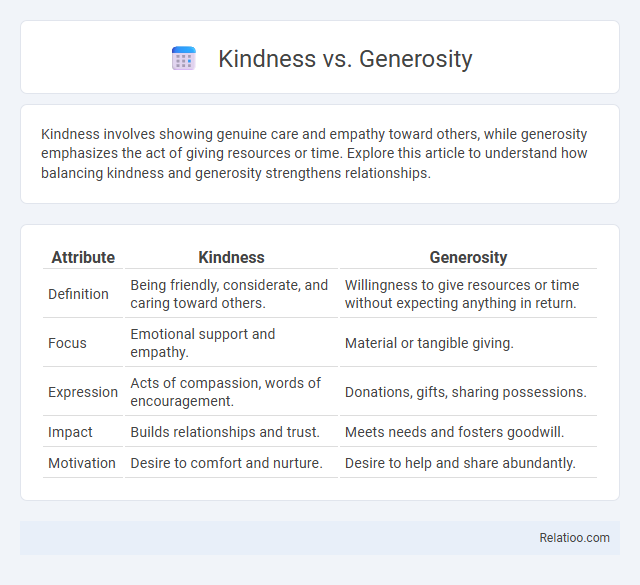Kindness involves showing genuine care and empathy toward others, while generosity emphasizes the act of giving resources or time. Explore this article to understand how balancing kindness and generosity strengthens relationships.
Table of Comparison
| Attribute | Kindness | Generosity |
|---|---|---|
| Definition | Being friendly, considerate, and caring toward others. | Willingness to give resources or time without expecting anything in return. |
| Focus | Emotional support and empathy. | Material or tangible giving. |
| Expression | Acts of compassion, words of encouragement. | Donations, gifts, sharing possessions. |
| Impact | Builds relationships and trust. | Meets needs and fosters goodwill. |
| Motivation | Desire to comfort and nurture. | Desire to help and share abundantly. |
Understanding Kindness: Definition and Scope
Kindness encompasses actions and attitudes aimed at promoting the well-being of others without expecting anything in return, reflecting empathy and compassion. It extends beyond mere gestures to include a genuine concern for others' feelings and needs, whereas generosity specifically refers to the willingness to give resources or time. Kindheartedness describes a person's inherent disposition toward kindness, highlighting the emotional foundation behind kind acts.
What is Generosity? Exploring Its True Meaning
Generosity is the act of giving resources, time, or support freely without expecting anything in return, often driven by a sincere desire to help others and improve their well-being. Unlike kindness, which can be expressed through small acts or words, generosity involves a tangible or substantial contribution that reflects selflessness and abundance. The true meaning of generosity lies in its capacity to foster connection and trust, promoting a culture of empathy and mutual support.
Key Differences Between Kindness and Generosity
Kindness involves showing consideration and empathy through thoughtful actions or words, while generosity specifically refers to willingly giving resources such as time, money, or possessions to others. Key differences between kindness and generosity lie in intent and expression: kindness centers on compassionate behavior that may or may not involve tangible giving, whereas generosity emphasizes the act of sharing material or immaterial assets without expecting anything in return. Kindheartedness encompasses an overall benevolent disposition, blending traits of both kindness and generosity into a consistent pattern of caring and goodwill.
Psychological Roots: Why We Practice Kindness and Generosity
Kindness, generosity, and kindheartedness share psychological roots deeply embedded in empathy and social bonding, which foster mutual trust and cooperation. Your brain releases oxytocin during acts of kindness and generosity, reinforcing positive feelings and promoting long-term psychological well-being. These behaviors evolve from intrinsic motivations to connect, nurture, and support others, ultimately enhancing both individual happiness and community resilience.
Everyday Examples: Kindness vs Generosity in Action
Kindness often shows up in small, thoughtful acts like holding the door open or offering a genuine compliment, while generosity involves giving resources such as time, money, or possessions without expecting anything in return. Kindheartedness reflects a consistent compassionate attitude, influencing your daily interactions by inspiring patience, empathy, and willingness to help others. Understanding these distinctions helps you recognize how simple everyday actions contribute differently to building positive relationships and community spirit.
The Impact on Relationships: Emotional Connections
Kindness fosters trust and warmth in relationships by promoting empathy and understanding, creating a foundation for emotional support. Generosity enhances bonds through acts of giving and selflessness, which build mutual appreciation and gratitude. Kindheartedness reflects a consistent inner compassion that strengthens emotional connections by encouraging patience and forgiveness.
Societal Benefits: How Kindness and Generosity Shape Communities
Kindness promotes social harmony by encouraging empathy and cooperation, creating stronger interpersonal bonds that enhance community well-being. Generosity, through acts of giving resources and support, directly addresses societal needs, fostering economic stability and collective growth. Your practice of kindness and generosity contributes to a resilient, inclusive society where individuals support one another, reinforcing a positive social fabric.
Challenges and Misconceptions: Common Myths Explained
Kindness, generosity, and kindheartedness often face misconceptions, such as generosity being solely about giving money, whereas it also includes time and attention. People may view kindness as a passive trait, yet it requires active effort and emotional investment. Kindheartedness is frequently mistaken for naivety, though it involves resilience and empathy despite challenges.
Developing Kindness and Generosity: Practical Tips
Developing kindness and generosity involves intentional actions such as practicing empathy, volunteering, and regularly expressing appreciation to others. You can cultivate kindness by actively listening and offering support without expecting anything in return, while generosity grows through sharing time, resources, or skills to benefit those in need. Building these qualities enhances your relationships and fosters a positive community impact by aligning your behavior with values of compassion and altruism.
Cultivating a Balanced Life: Integrating Both Values
Cultivating a balanced life involves harmonizing kindness, generosity, and kindheartedness by recognizing their distinct roles: kindness fosters empathy and connection, generosity emphasizes giving beyond oneself, and kindheartedness reflects an inherent disposition of goodwill. Integrating these values leads to sustainable relationships and personal well-being, as kindness nurtures trust, generosity promotes community support, and kindheartedness sustains emotional resilience. Prioritizing this triad creates a holistic approach to living that enhances social bonds and inner fulfillment simultaneously.

Infographic: Kindness vs Generosity
 relatioo.com
relatioo.com